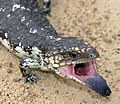Blue-tongued skink
Blue tongue lizard redirects here.
| Blue-tongued skinks | |
|---|---|

| |
| Tiliqua scincoides showing its blue tongue | |
| Scientific classification | |
| Kingdom: | Animalia |
| Phylum: | Chordata |
| Class: | Reptilia |
| Order: | Squamata |
| Family: | Scincidae |
| Subfamily: | Egerniinae |
| Genus: | Tiliqua Gray, 1825[1] |
| Species | |
|
8, see text. | |
| Synonyms | |
|
Trachydosaurus | |
Blue-tongued skinks make up the Australasian genus, Tiliqua, which has some of the largest members of the skink family (Scincidae). They are also called blue-tongued lizards or simply blue-tongues, shinglebacks or the sleepy lizard in Australia.[2] The main feature of the genus is a large blue tongue that can be used to scare away enemies.
Distribution
Blue-tongued skinks are closely related to the genera Cyclodomorphus and Hemisphaeriodon. All species are found on mainland Australia except Tiliqua gigas which lives in New Guinea and various islands of Indonesia. One subspecies of Tiliqua scincoides is also found on several small Indonesian islands between Australia and New Guinea. Tiliqua nigrolutea is the only species in Tasmania. With the exception of the pygmy blue-tongue, they are large lizards which can grow up to 45 cm total length. They are light-bodied, short-limbed, broad with a distinct head and dull teeth.
Ecology
Most species are diurnal ground-foraging omnivores, feeding on insects, gastropods, flowers, fruits and berries.[3] The pygmy blue-tongue however mainly eats arthropods. The skinks give birth to live young. The litter sizes ranging from 1–4 in the pygmy blue-tongue and shingleback to 5–24 in the eastern and northern blue-tongues.[4]
Species and subspecies
- Tiliqua adelaidensis, (Adelaide) Pygmy Blue-tongued Skink
- Tiliqua gigas, Indonesian Blue-tongued Skink
- Tiliqua sp., Irian Jaya Blue-tongued Skink
- Tiliqua multifasciata, Centralian Blue-tongued Skink
- Tiliqua nigrolutea, Blotched Blue-tongued Skink
- Tiliqua occipitalis, Western Blue-tongued Skink
- Tiliqua rugosa, Shingleback (or Sleepy Lizard)
- Tiliqua rugosa rugosa, Common Shingleback
- Tiliqua rugosa aspera, Eastern Shingleback
- Tiliqua rugosa palarra, Shark Bay Shingleback
- Tiliqua rugosa konowi, Rottnest Island Shingleback
- Tiliqua scincoides, Australian Blue-tongued Skink
Eastern Blue-tongued Lizard in metropolitan Sydney.
Stump-tailed skink, Tiliqua rugosa
Blue-tongued Skink Media
Notes
- ↑ Gray, J.E. (1825). A synopsis of the genera of reptiles and Amphibia, with a description of some new species. Annals of Philosophy 10:193—217. p. 201
- ↑ Torr, Geordie (July 1999). "True Blue". Australian Geographic. 55: 55–67.
- ↑ Cogger, H. G. (2000). Reptiles and Amphibians of Australia. Reed New Holland. ISBN 978-0801427398.
- ↑ Turner, Grant (2001). Keeping Bluetongue Lizards. Australian Reptile Keeper Publications. ISBN 978-0-9586050-6-9.
References
- Austin, J.J. & Arnold, E.N. (2006): Using ancient and recent DNA to explore relationships of extinct and endangered Leiolopisma skinks (Reptilia: Scincidae) in the Mascarene islands. Molecular Phylogenetics and Evolution 39(2): 503–511. (HTML abstract)
- Bull, C.M. (1988): Mate fidelity in an Australian lizard Trachydosaurus rugosus (Scincidae). Copeia 1987(3): 749-757.
- Bull, C.M. (1990): Comparison of displaced and retained partners in a monogamous lizard Tiliqua rugosa. Australian Wildlife Research 17: 135-140.
- Valentic, R.A. (1996): A prey record of the Eastern Blue-tongue Tiliqua scincoides for the common brown snake Pseudonaja textilis. Monitor Archived 2009-10-02 at the Wayback Machine 8(3): 155.
Other websites
| Wikimedia Commons has media related to Lua error in Module:Commons_link at line 62: attempt to index field 'wikibase' (a nil value).. |
- Bluetongue fact file
- Blue-tongued Lizards in New South Wales
- Operation Bluetongue - Citizen Science study project at UniSA Archived 2011-08-16 at the Wayback Machine
- Site devoted exclusively to blue-tongued skinks
| Wikimedia Commons has media related to Lua error in Module:Commons_link at line 62: attempt to index field 'wikibase' (a nil value).. |











